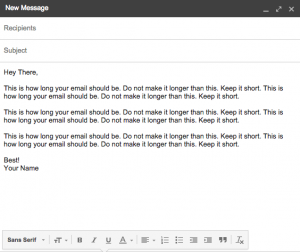Let’s start with the obvious. You use AdWords. I use AdWords. Everybody uses AdWords.
There’s an entire industry built around using AdWords. Keyword phrases like “PPC management” and “AdWords consultant” currently go for around $ 30 a click.
Why? Because love it or hate it, Google is king.

Here’s the problem. Optimizing AdWords is hard, time consuming, nit-picky work. So why not just get your ads out there, put something up, and let it run?
Sure, you won’t get the best results – you most likely won’t even get good results – but you’ve got crazy money to donate to Google anyway, right?
So, if you want to ruin your AdWords campaigns and see your conversion rates tank, then be sure to follow these seven all-too-common AdWords mistakes.
(Oh, and just in case you don’t want horrible results, I’ve provided some helpful tips for on what to do instead.)
1. Don’t Use Keywords in Your Ad Copy
Effective AdWords campaigns live and die by the right keywords.
You know this, and that’s why you spend so much time researching and choosing the right keywords for your ads. Unfortunately, very few of us spend an equal amount of time creating customized ads with those exact keywords in the actual copy.
As long as you end up appearing on the right search pages, that should be enough, right?
Wrong.
The truth is people are far more likely to click on the ads that match the keywords and search queries they just typed in.
But, since it’s so time-consuming to create unique ads for each ad or ad group, to kill your CTR just go ahead and plug in the most generic copy possible. Or you could use Dynamic Keyword Insertion as a shortcut to insert keywords on your behalf, which might actually hurt your ad performance or worse, put you in legal hot water.

Of course, if you’re interested in ads that get clicks for the right reasons, you’ll want to focus on using relevant keywords in your ads themselves. In fact, create custom ads for each keyword set that matches the search query exactly.
Also remember that you shouldn’t just go after every related search query either. Stick to intent-based keywords that reflect the goal on your linked page.

For instance, if you’re looking to build your lead list by providing quality content, target informational search queries like “What type of leather makes the most durable couch?”
If, however, you’re trying to target buyers, focus on commercial-intent keywords. These include those with direct purchase intent, such as “Where to buy a leather couch,” or local keywords such as “leather couches San Diego.”
2. Don’t Use Negative Keywords in Your Settings
Identifying negative keywords in your AdWords campaign ensures that Google doesn’t show your ads for searches with those particular words.
But for you, there are no such things as negative keywords, right? All publicity is good publicity, isn’t it?
For instance, let’s say you’re selling business insurance and your ad appears right under “business insurance scams.” That’s cool. At least someone is seeing your ad!
Okay, so you’re not that insane.
Some keywords are harmful to your business. If you’re in car sales and you’re appearing on searches for car care tips, that’s bad news. While you might get a lot of clicks to your website – in which case you can tell your boss that your ads are getting a ton of clicks – that’s not the kind of traffic you want.
Why? Because none of these people are in the market for a car.

But if you actually care about the reputation of your business, as well as getting real conversions and a high CTR, negative keywords are definitely something you’ll want to focus on.
AdWords actually suggests possible Negative Keywords for you to get started. These won’t be definitive, but they’ll definitely help you hit the ground running.
You will also need to keep looking out for more negative keywords as time goes on. Your sales team might be able to give you more information about the types of customer queries that make a user unqualified for your product, or you might see a lot of traffic going to your site for unrelated terms.
3. Don’t Use Locations
You operate a business online, so who needs boundaries? Why limit yourself to a few select areas when you can just create one ad and target everyone across the world all at once?
Creating location-specific ads may bring more qualified traffic, but they take a lot of time, so let’s just stick with that generic ad that targets everyone under the sun.

So, why should you invest in location targeting?
People in different locations behave and shop differently. If you’re an online shoe retailer like Zappos, for example, you might have a lot more luck selling Ugg boots to someone in Boston in the winter than to someone in Jamaica, where it’s sunny all year round.
Another important thing to remember is that each geographic target might respond differently to ads based on their income levels and lifestyle. Your average family living in suburban zip codes might respond to your car ads better than someone living in the city.

Now, if you are running a location-based business, I probably won’t have to extol the virtues of local search, but let’s take a look anyway because it’s that important.
New Google research says that 50% of mobile users and 34% of consumers on tablets or desktops are most likely to visit a store within a day after conducting a local search. This means that if you’re not optimizing your ad based on your location, you could be missing out of a lot of immediate traffic.
For more, check out WordStream’s guide to geo-targeting.
4. Send Your PPC Traffic to Your Home Page
All this talk of super-targeted ads and landing pages is pointless, right? Why send your ad traffic to a specific page with just one offer directly linked to the ad they just clicked when you can send them to your homepage to see everything you have? Won’t that get you more exposure? After all, your homepage lets your visitors choose what they want.
Of course, this kind of thinking completely ignores the fact that people who click on ads are looking for immediate solutions and, if they don’t find them, they’ll click away and go looking elsewhere.
But, you might protest, as long as my website looks great, some of them will stick around. Eventually a few might find what they’re looking for … if they’re desperate enough.
If, however, you don’t want to leave it up to chance, your keywords, ad text and landing page need to be relevant to each other. In fact, Google uses the relevance of your landing page to help determine the Quality Score of your ad, which, in turn, affects its placement and cost.
A great example of doing this wrong is Best Buy’s ad and landing page. While the page is relevant to the ad, Best Buy could do a better job by making sure that content from the ad copy, such as free shipping and store pickup, are mentioned prominently on the landing page.

Here’s the ad… (Source: Google.com Screenshot)

…and here’s the landing page (Source: BestBuy.com Screenshot)
5. Don’t Test Anything
Testing is for wimpy amateurs with no self-confidence, right?
You’re smarter than that. You know your audience and you’re a brilliant copywriter, so once you set your keywords, you write a snazzy headline and forget about it.

Of course, you’d never say something outlandish like that out loud. But the reality is … testing is drastically underutilized.
The only way to know for sure that your ads are performing at their best is to test various elements and compare to see which version gives more conversions. You can try using different keywords, various headings or body copy, different placements, locations, landing pages – the options are almost endless.
There are, of course, best practices when it comes to executing any A/B testing strategy, but ignore these three and you’ll most certainly fail:
- Only change one element per test.
- Have a clear hypothesis for each test.
- Watch results over time and pay attention to volume (the number of exposures) not just initial bumps or falls before declaring the results of any test. Some tests may perform extremely well or poorly, but change after a few days or weeks.
6. Don’t Change the ‘Big’ Stuff
You don’t sweat the big stuff, do you? You’re perfectly okay with adding or removing a few words, switching up a paragraph or two, maybe changing the color of that button from green to red.
Here’s the problem: small changes only give you small results. You can’t only test small changes, you have to go unicorn hunting!
Do something radical like changing the overall layout or background of your landing page and see the effect it has on your visitors. Change the concept of your ad completely – if you were taking a positive approach and being friendly, try doing the opposite and sparking fear by showing readers what they will miss out on by not clicking.
The irony is, big changes like these actually get harder the more advanced you are in the field.
Copywriters and designers gain confidence in their work and, as a result, feel that they know what they’re doing. We become afraid to sacrifice what is considered quality work for something that might perform better but is less aesthetically pleasing.
But if what you want is results, you have got to go against conventional wisdom, and your own mind, and try things that might not be so intuitive at first.
A perfect example of this is the way Basecamp, the company that develops the popular project management tool Highrise, made some huge changes to their landing page and saw tremendous results. Take a look at how providing less information and a friendly face brought them a 102.5% increase in clicks.

Highrise A/B Test on Landing Page (Source: Basecamp)
7. Don’t Bother Creating an Autoresponder
If you read that subheading thinking “What autoresponder? I just let my mail service provide that,” then kudos to you!
Not only are you well on your way to ruining your AdWords campaign, you’re also ruining any potential of a good relationship with those who actually convert.
When people click through from your ads and sign up for your offer or buy from you, the least you can do is reach out and thank them for doing so. However, if you’re in the game just to collect emails so you can boast about the size of your list, then feel free to forget about this step.
But, for those who want to build relationships with the people who convert, then you’ll want to go further than just saying thanks and create autoresponders that offer even more value and engages your visitors even further.
This is no simple task and will be almost impossible to execute manually, but an autoresponder tool, like this one from GetResponse, will make you look like a star in your visitor’s eyes.
For example, you can set a trigger for an email to be sent the moment someone purchases an item – it could include recommendations for other items, a coupon for a future purchase, or any other offer you think might be relevant.
Or, if the person signed up for an offer, you can set up an automatic email to go out a few days later asking them if they enjoyed your offer and have any questions they would like answered.
There are numerous other possibilities. The important thing to remember is to provide value and engage them in a way so that they keep interacting with your business after the initial conversion. Otherwise, you will only be wasting money down the line advertising to them again when you already had the opportunity to capture them before.
Killing Your Campaigns Is Easy …
Lack of effort and over-confidence in your ability is all it takes.
If you want to make a difference, however, and boost your conversion rates, be sure you’re following these seven tips:
- Using keywords in your ad copy will make them perform better, but always remember to use high-intent keywords based on your goals to avoid pointless clicks that won’t drive conversions.
- Negative keywords keep your ads from appearing in harmful, irrelevant, or unrelated searches that minimize clicks from searchers who aren’t looking for what you have to offer.
- Location targeting is important, even if your product is available worldwide. Narrow your audience to be more specific in your ads.
- Your landing pages must be highly relevant, with wording that matches and follows through on the ad itself.
- Testing is for everyone, no matter how experienced you are.
- You can change minor elements to see the effect, but you should consider larger elements too as these can net you big results.
- What you do after conversion matters. Make sure to follow up with an engaging autoresponder message via email to say thanks and provide even more value.

(214)
Report Post





